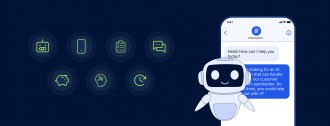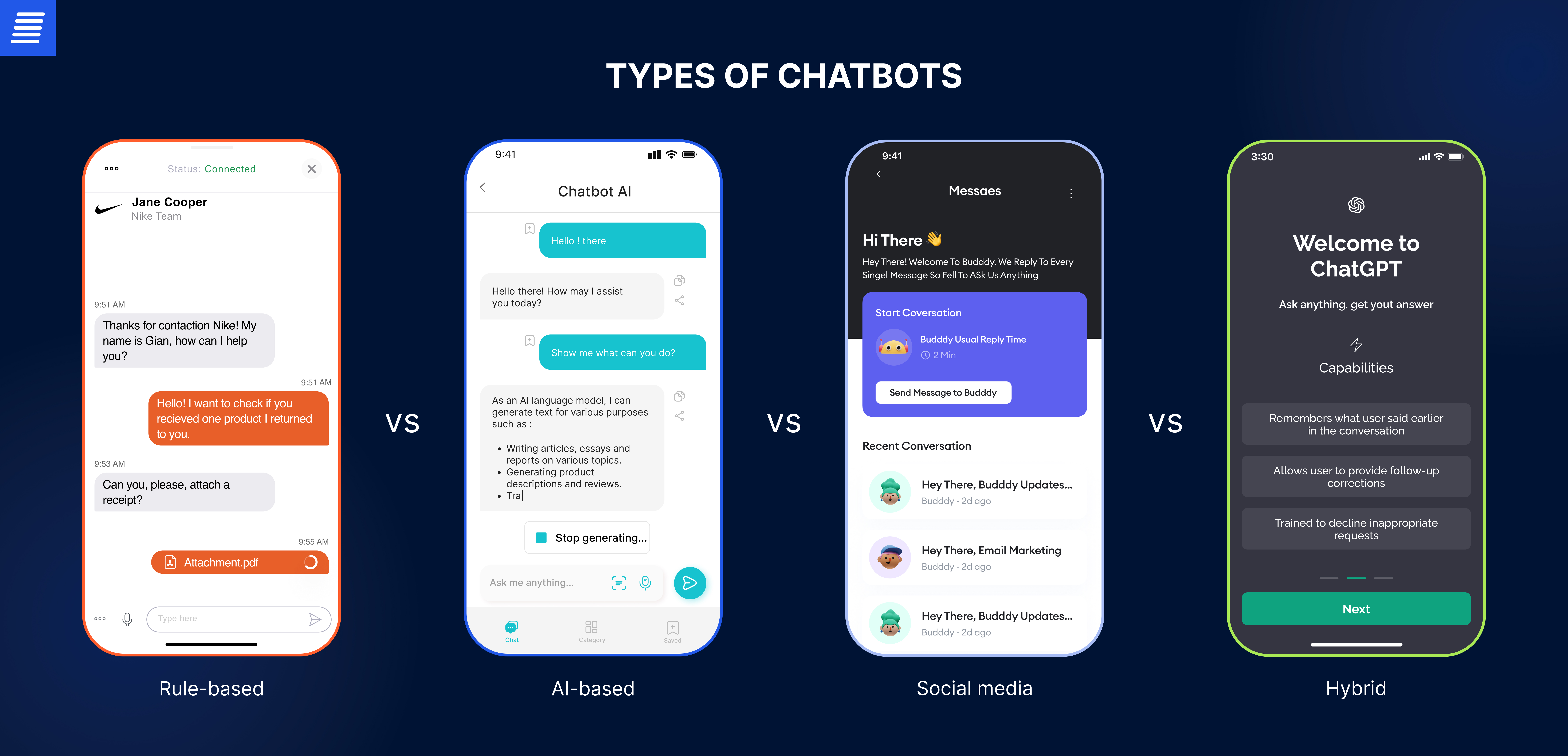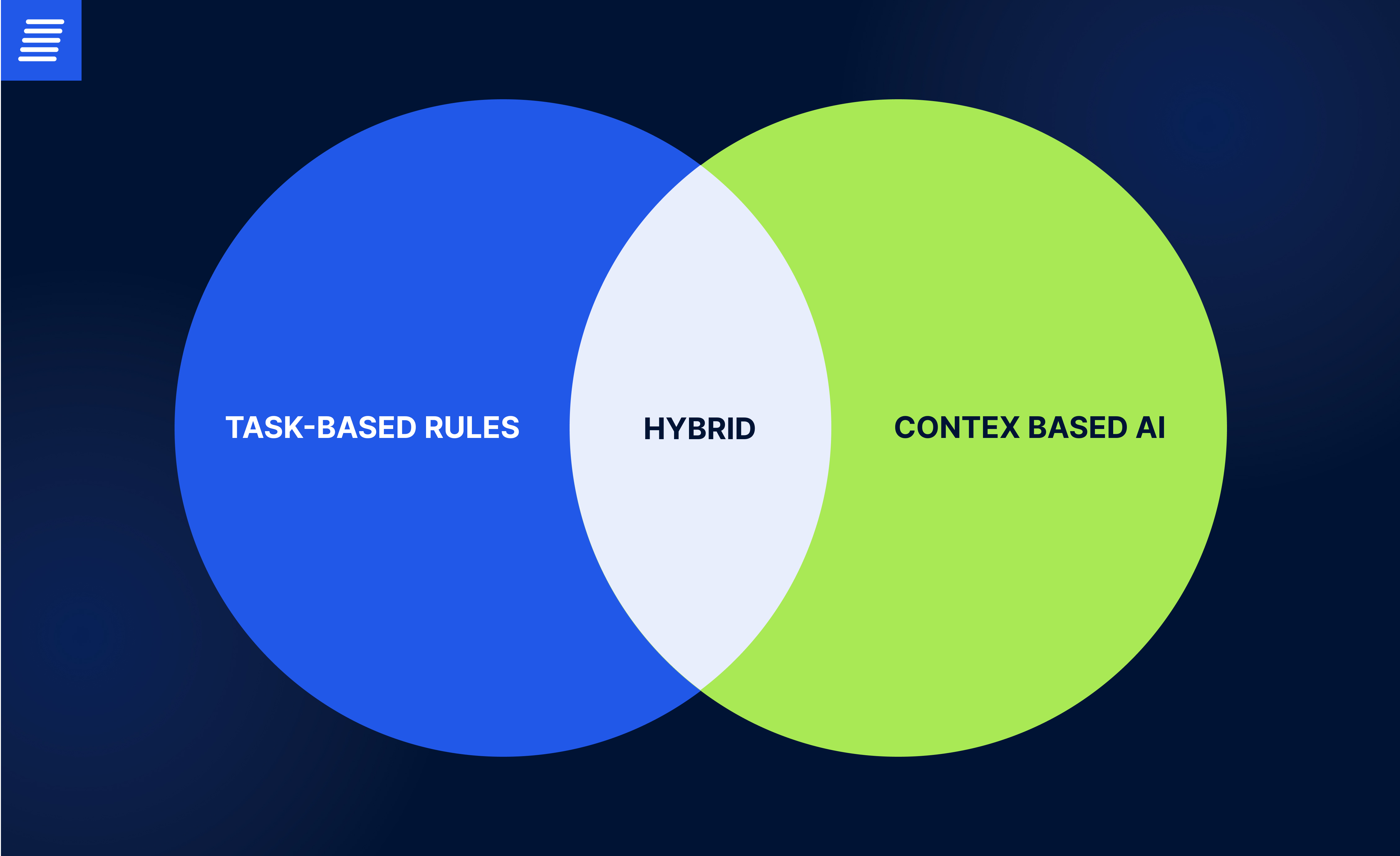
Contact us
Our team would love to hear from you.

A chatbot is a computer program designed to simulate conversation with human users over the internet. Chatbots can be used for a wide range of applications, including customer service, lead generation, and e-commerce.
The rise of chatbots can be attributed to advances in artificial intelligence (AI) and natural language processing (NLP) technology, which have enabled chatbots to become more sophisticated and effective at simulating human conversation. As a result, businesses can now use chatbots to provide customers with an instant and personalized response to their queries, without the need for human intervention.
While chatbots may seem like a new innovation, they have existed in some form since the mid-1960s. Here are some key milestones in the development of chatbots:
ELIZA, an NLP program created in 1966 by MIT computer scientist Joseph Weizenbaum, is widely considered the first chatbot. ELIZA was designed to simulate a conversation with a psychotherapist by using simple pattern matching and substitution of user inputs. ELIZA was an early example of NLP and had a significant influence on the development of chatbots and AI as a whole. Its simple approach to conversation and pattern recognition laid the foundation for the more sophisticated chatbots we see today.
Another early chatbot was PARRY, created by psychiatrist Kenneth Colby in the 1970s. PARRY was designed to simulate a person with paranoid schizophrenia to help researchers better understand the condition and improve treatment. PARRY was a more sophisticated chatbot than ELIZA, with the ability to maintain more coherent and engaging conversations. PARRY was able to engage in extended conversations with researchers and even demonstrated some self-awareness, claiming at times that it was not truly human.
Jabberwacky is an AI-powered chatbot created by British programmer Rollo Carpenter in 1988. It was initially designed as a game that could be played with text messages, where players would try to determine whether they were talking to a human or a machine. Over time, Carpenter improved the chatbot’s abilities, using machine learning (ML) techniques to allow it to learn from its conversations with users and generate more natural responses. The chatbot was also designed to have a sense of humor and would often engage in witty banter with users. Today, Jabberwacky is still available online and has evolved into a chatbot that can hold conversations on a wide range of topics.
ALICE, also known as Artificial Linguistic Internet Computer Entity, is a popular chatbot created by Richard Wallace in 1995. Similar to Jabberwacky, ALICE was designed to simulate conversation with humans and has the ability to learn from its conversations. One of ALICE’s distinguishing features is its ability to interpret and generate language. It uses NLP techniques to analyze and understand user input and can generate responses that are grammatically correct and contextually appropriate.
SmarterChild was a popular chatbot created by ActiveBuddy in 2001. It was one of the first chatbots to be widely adopted by consumers, particularly young people, who used it to send and receive text messages through various instant messaging platforms. SmarterChild was designed to provide users with a wide range of information and services. It could answer questions, provide news updates, and even play games with users. It was particularly popular among young people, who used it to pass the time and engage in playful banter.
Siri is a virtual assistant and chatbot developed by Apple Inc. for its iOS, iPadOS, watchOS, macOS, and tvOS operating systems. It was first introduced on the iPhone 4S in 2011 and has since become one of the most well-known and widely used virtual assistants. Siri uses NLP and ML to understand user requests and generate responses. It can perform a wide range of tasks, including sending text messages, making phone calls, setting reminders, playing music, and providing directions.

Chatbots work by using natural language processing (NLP) and machine learning algorithms to understand and respond to user inputs. When a user interacts with a chatbot, the bot analyzes the input, identifies the intent behind it, and generates a relevant response. The general process of how a chatbot interacts with users is as follows:
There are several types of chatbots that serve different purposes and functionalities. Here are some common types of chatbots:

Rule-based chatbots operate based on a predefined set of rules and responses. These chatbots are programmed to follow a specific flow of conversation and provide predetermined answers to user queries. The rules are typically created by the developers to cover a range of possible user inputs and guide the responses accordingly.
One of the main advantages of rule-based chatbots is their simplicity and ease of implementation. Since the rules are predefined, developers have control over the conversation flow and can ensure that the chatbot provides accurate and relevant information to users. Rule-based chatbots are often used in scenarios where the conversation is limited and can be easily predicted, such as customer service inquiries or FAQ interactions.

AI-based chatbots leverage machine learning and natural language processing (NLP) algorithms to understand and respond to user queries in a more intelligent and human-like manner. Unlike rule-based chatbots, AI-based chatbots have the ability to learn from interactions with users and improve their responses over time.
One of the key advantages of AI-based chatbots is their ability to handle complex and unpredictable conversations. These chatbots can analyze user inputs, understand context, and provide more personalized and contextually relevant responses. They can also adapt to new information and trends, making them more versatile and effective in a wide range of scenarios. AI chatbots also integrate with external systems and APIs to provide more comprehensive and accurate information to users. Additionally, AI-based chatbots can use sentiment analysis to detect the emotional tone of user messages and tailor their responses accordingly.
Social media chatbots are automated programs that interact with users on social media platforms, such as Facebook, X, and Instagram. These chatbots are designed to engage with users, answer questions, provide information, and even facilitate transactions through messaging interfaces.
Hybrid chatbots are a combination of rule-based and AI-powered chatbots that leverage the strengths of both approaches to provide more effective and versatile conversational experiences. Rule-based chatbots rely on predefined rules and decision trees to respond to user queries, while AI-powered chatbots use NLP and ML algorithms to understand and generate responses based on context. By combining rule-based and AI-powered capabilities, hybrid chatbots can deliver a more seamless and intelligent conversational experience.

The implementation of the chatbot reduced the company’s service costs and significantly enhanced customer service.
Building a custom chatbot for your company can bring other benefits. Here are some of the reasons why you might consider before ordering a custom chatbot development:
A chatbot can be tailored to your company’s unique needs and requirements, which can improve the customer experience. A chatbot can answer customer questions quickly and efficiently, provide personalized recommendations, and help customers navigate through your products or services.
A chatbot can handle multiple customer inquiries simultaneously, freeing up your customer support team to focus on more complex issues. This can help to increase efficiency within your organization and reduce response times.
By automating repetitive tasks, a chatbot can reduce costs associated with customer support. This can be especially valuable for small businesses or startups that are looking to manage costs while still providing a high level of customer service.
A chatbot can be available to customers around the clock, even outside of business hours. This can help to provide a better customer experience and improve customer satisfaction.
A chatbot can be integrated with your company’s existing systems and workflows, such as CRM software or e-commerce platforms. This allows streamlining processes and reducing manual tasks.
A chatbot can collect analytics data on customer interactions, which can provide valuable insights into customer needs and preferences. This data can be used to improve products or services, identify trends, and inform marketing and sales strategies.
With a growing number of businesses emerging every day, it’s becoming increasingly challenging for enterprises of all sizes to stay ahead of the competition and thrive. One way for organizations to address this challenge is by integrating generative artificial intelligence (AI) into their business operations.
With advances in natural language processing and machine learning, chatbots are becoming increasingly sophisticated and are being deployed in more and more industries. These are just a few examples of the many use cases for chatbots:
Chatbots can provide 24/7 support to customers by answering common questions, handling simple inquiries, and escalating complex issues to human agents when necessary.
Chatbots can help customers browse products, place orders, and track shipments. They can also provide personalized recommendations based on customers’ purchase history and preferences.
Chatbots can assist healthcare providers by answering common patient questions, scheduling appointments, and reminding patients to take their medication.
Chatbots can help customers manage their finances by providing account information, answering questions about banking products, and providing investment advice.
Chatbots can be used in educational settings to provide students with personalized tutoring, answer questions about course materials, and provide study resources.
Chatbots can help travelers book flights and hotels, provide information about local attractions, and offer personalized travel recommendations based on users’ preferences.
Chatbots can provide users with personalized movie and TV show recommendations, trivia games, and other interactive experiences.
Chatbots can deliver news and media content directly to users, provide personalized news recommendations, and engage users in conversation about current events.
The choice between a custom chatbot and a ready-made chatbot depends on the specific needs and requirements of the business. A custom chatbot is built specifically for a particular business or organization and is designed to meet the unique needs and requirements of that organization. Custom chatbots are built from scratch and can be tailored to the specific use cases, goals, and target audience of the business. They can be integrated with existing systems and workflows, and can be trained on the specific terminology and language used in the business.
On the other hand, a ready-made chatbot is a pre-built solution that is designed to be used by multiple businesses across different industries. Ready-made chatbots can be open source so that developers can do fine-tuning for custom needs. They may be less expensive and quicker to implement than custom chatbots, as they don’t require the same level of development time and resources.
If a business has unique use cases or requirements that are not addressed by a ready-made chatbot, a custom chatbot may be the better option. Custom chatbots can be more expensive and time-consuming to develop, but they can also provide a higher level of customization and functionality.
But if a business has more standard use cases and requirements that can be addressed by a ready-made chatbot, it may be more cost-effective and efficient to use a ready-made solution. Such chatbots can be more affordable and quicker to implement, but they may not offer the same level of flexibility as a custom chatbot.
Ultimately, the decision between a custom chatbot and a ready-made chatbot depends on the specific needs, goals, and budget of the business.
Let’s dive deeper into the reasons why a custom chatbot may turn out to be a better option:
A custom chatbot can be designed to meet the unique use cases and requirements of a particular business. This can be especially important for companies that have complex workflows, unique processes, or specialized industry terminology that is not addressed by a ready-made chatbot.
With a custom chatbot, businesses have the ability to customize the user interface, conversation flow, and functionality to meet their specific needs. This level of customization can provide a more personalized and engaging user experience for customers.
A custom chatbot can be integrated with existing systems and workflows, such as customer relationship management (CRM) software, to provide a more seamless experience for users. This can help improve efficiency and reduce manual processes.
There are many reasons why you might consider building a custom chatbot for your company. It can provide a range of benefits, from improving the customer experience to providing valuable data insights and helping your business stay competitive in today’s market. Chatbots can not only answer questions but can send notifications, collect anonymous feedback, connect people with system administrators, send thematic news, etc.
Customizing a chatbot to suit the specific needs of a business is an increasingly common practice that leverages the potential of Large Language Models (LLMs) and pre-trained models with open-source code. With the abundance of models available for free access on platforms such as Hugging Face, businesses have a wealth of options at their fingertips to start with. However, the real challenge lies in customization and deployment to calibrate with unique business requirements and objectives.
The first step in customization involves choosing the right base model. This decision is critical as it sets the foundation for the chatbot’s capabilities. LLM APIs or pre-trained open-source models serve as starting points. Businesses can select models based on factors such as language support, knowledge domain, complexity, and performance metrics. Platforms like Hugging Face not only offer a vast repository of models but also provide detailed documentation and community feedback, aiding in the selection process.
Once a suitable model is identified, the next step is customization. This involves training the model with specific data relevant to the business’s domain. Customization can also extend to the chatbot’s personality, tone of voice, and interaction style, ensuring consistency with the brand’s image and customer engagement strategies.
Deployment is where resource considerations come into play. Running LLMs or even moderately complex models requires significant computational power, memory, and storage. Businesses need to evaluate whether to deploy on-premises or in the cloud. On-premises deployment offers control and security but can be costly in terms of hardware and maintenance. Cloud-based deployment, on the other hand, provides scalability and flexibility. Business owners should weigh the costs, scalability, security, and compliance aspects when choosing a deployment strategy.
To manage these resources efficiently, businesses can employ strategies such as serverless computing, which allows for scaling based on demand, and containerization, which facilitates easy deployment and management of applications across different environments.
To sum up, chatbots are a valuable and adaptable resource for companies seeking to improve customer interaction, simplify processes, and decrease expenses. With the continuous evolution of technology, chatbots are poised to have an even greater impact on business operations and customer engagement. By partnering with EffectiveSoft, you can develop a sophisticated and intelligent chatbot that enhances customer engagement, improves efficiency, and drives business growth. Contact us to learn more about our chatbot development services and start building a powerful chatbot for your business.
Our team would love to hear from you.
Fill out the form, and we’ve got you covered.
What happens next?
San Diego, California
4445 Eastgate Mall, Suite 200
92121, 1-800-288-9659
San Francisco, California
50 California St #1500
94111, 1-800-288-9659
Pittsburgh, Pennsylvania
One Oxford Centre, 500 Grant St Suite 2900
15219, 1-800-288-9659
Durham, North Carolina
RTP Meridian, 2530 Meridian Pkwy Suite 300
27713, 1-800-288-9659
San Jose, Costa Rica
Escazú Corporate Centre, Piso 6
40602, 1-800-288-9659